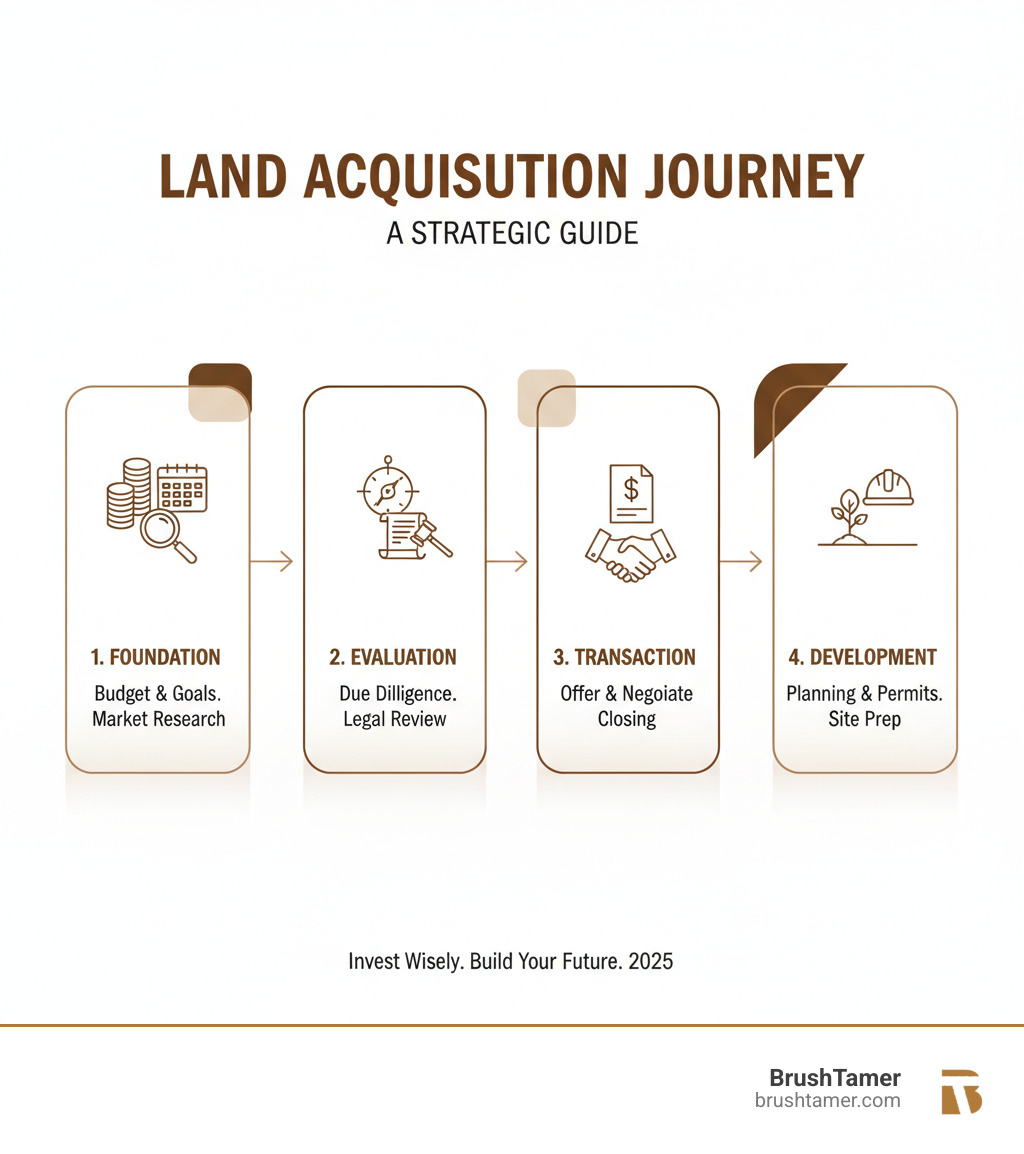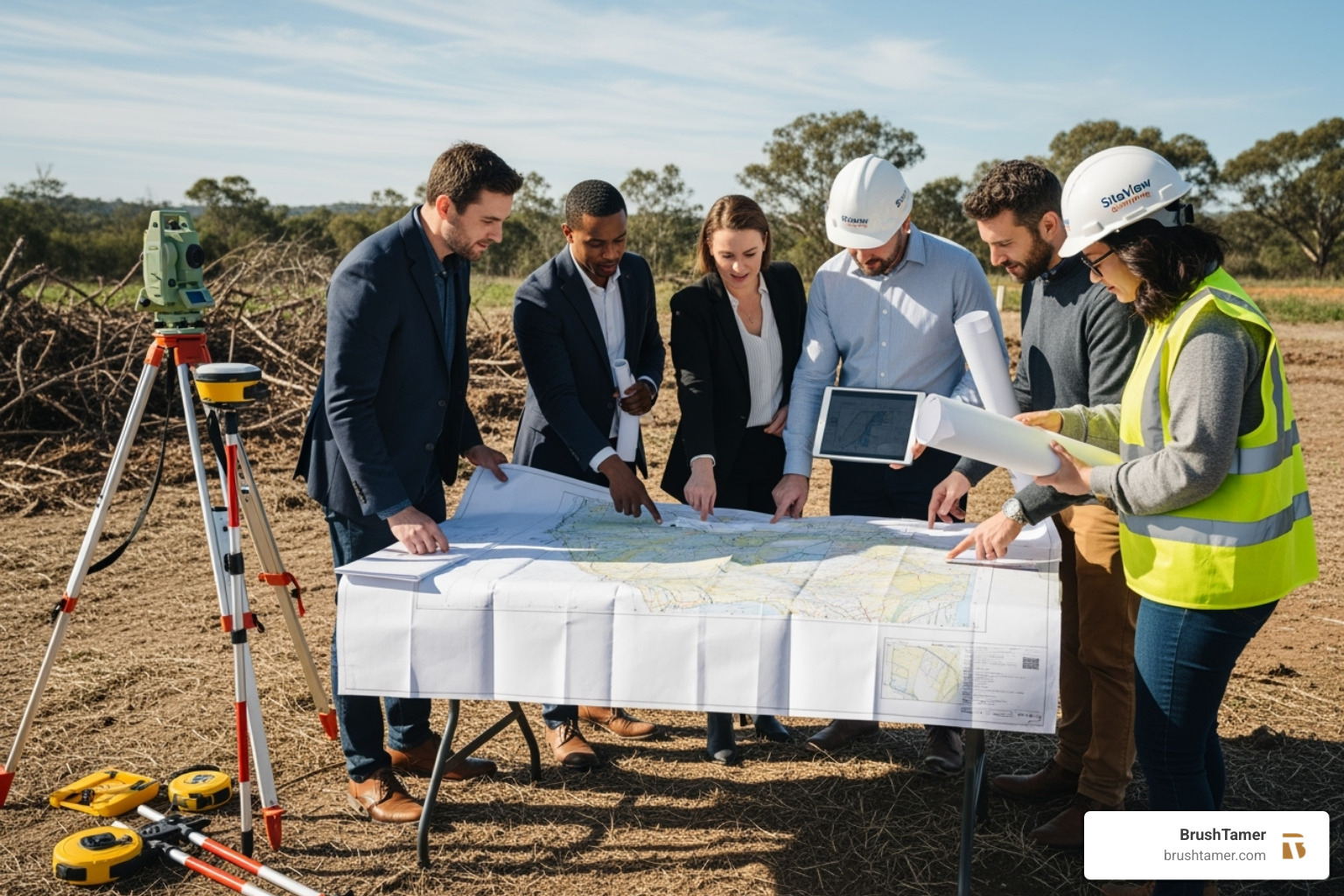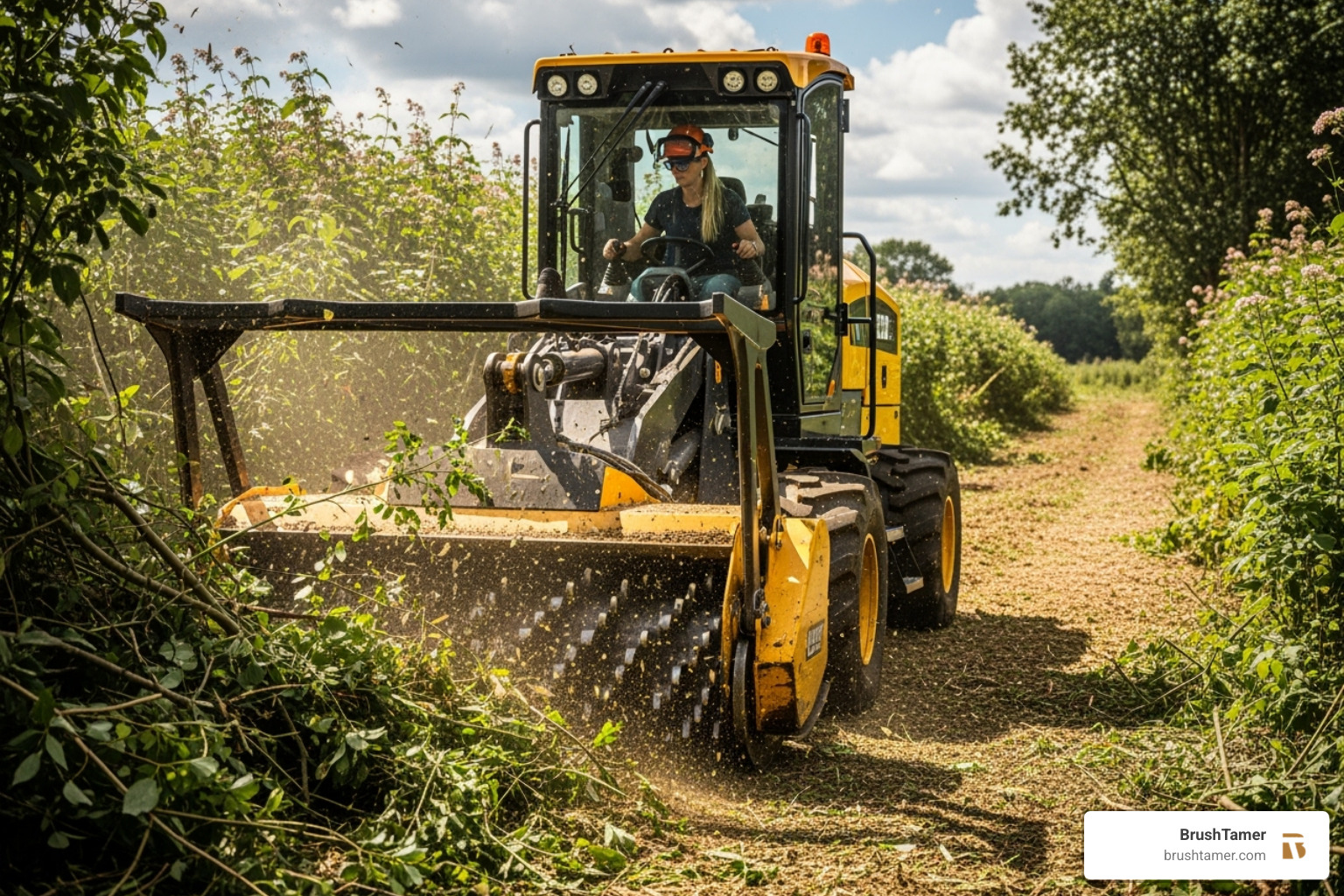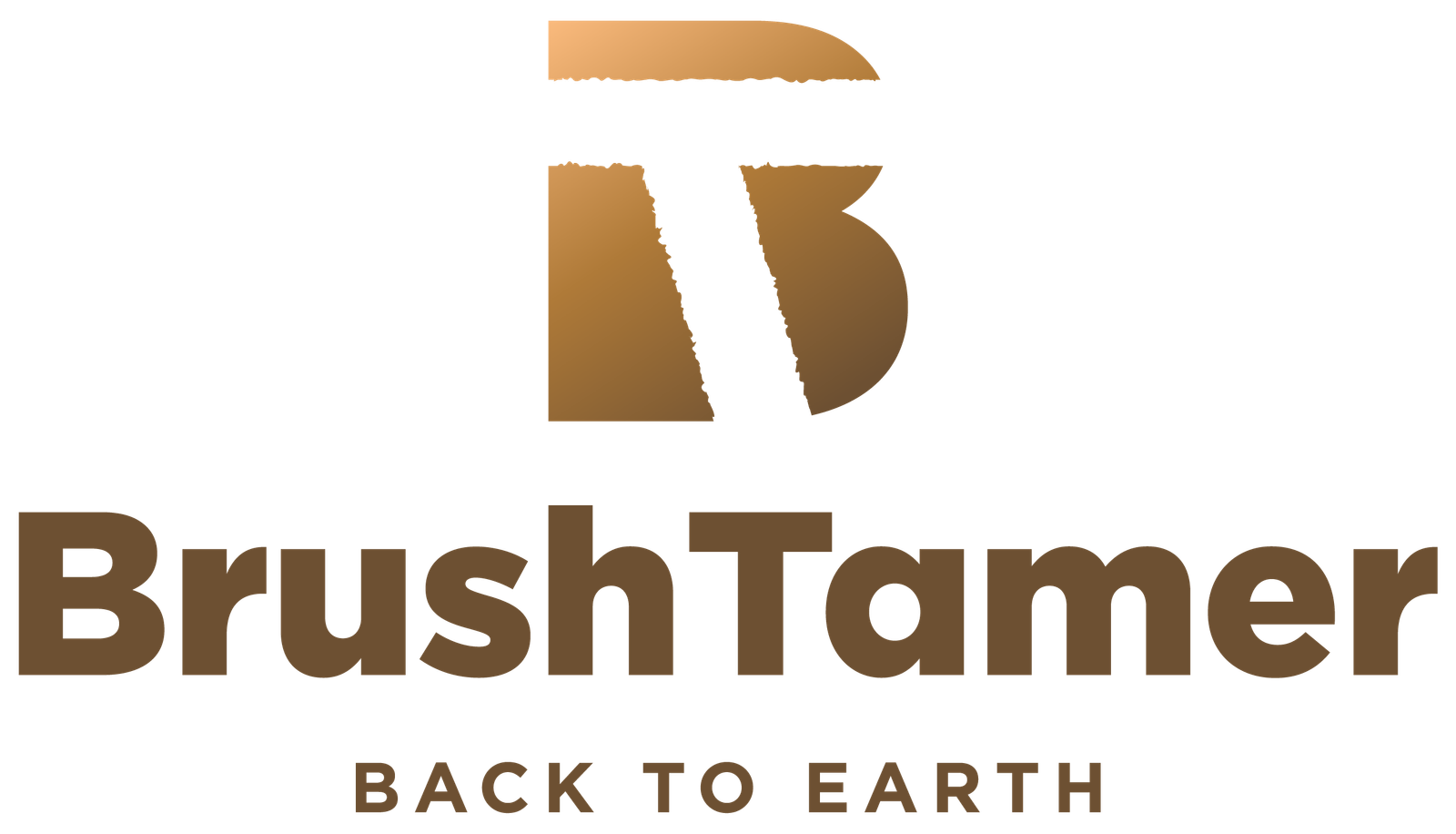Why Buying Land is Your Path to Property Ownership
The dream of owning a piece of the earth is deeply ingrained in the American spirit. It represents freedom, a tangible legacy, and a direct investment in your future. When you’re ready to buy land, you are embarking on a journey that offers unparalleled opportunities for personal and financial growth. The process, however, is more complex than buying a house and requires a unique set of knowledge. This comprehensive guide breaks down the entire land buying process into five essential steps: defining your purpose, researching properties, conducting due diligence, closing the deal, and preparing your land for use. Whether you envision a custom-built family home, a sprawling agricultural enterprise, a private recreational getaway, or a strategic long-term investment, mastering each phase is the key to making a sound and rewarding purchase.
Key Steps to Buy Land:
- Define your purpose and budget – Go beyond a simple idea and create a detailed vision. Determine if you need agricultural, residential, commercial, or recreational land, and establish a comprehensive budget that includes all associated costs.
- Research and find properties – Utilize a multi-pronged approach combining online listings, specialized real estate agents, public records, and local market data to identify promising opportunities.
- Conduct due diligence – This is the critical investigation phase. Perform title searches, commission property surveys, conduct soil tests, and complete environmental assessments to uncover any potential issues before you buy.
- Make an offer and close – Navigate the legal and financial intricacies of contracts, contingencies, and closing procedures to ensure a smooth and secure transfer of ownership.
- Prepare your property – Transform your raw land into a usable asset by clearing vegetation, establishing boundaries, grading a build site, and connecting essential utilities.
The path to land ownership can feel daunting, but with careful planning, expert advice, and a clear understanding of the process, success is well within reach. I’m Leon Miller, owner of BrushTamer. For years, my team and I have partnered with new landowners, helping them navigate the final, crucial steps of site preparation. My extensive experience in land management and clearing has shown me time and again that professional preparation is not just a final task—it’s the foundational step that turns a piece of property into a place of value. This guide is designed to empower you with the knowledge to not only buy land but to do so with confidence and foresight.

Step 1: Defining Your Purpose and Budget

Before you even begin to browse listings, the most critical first step is to define your vision with absolute clarity. Why do you want to buy land? Your answer to this question will act as a compass, guiding every subsequent decision. Are you dreaming of building a custom home, creating a long-term financial asset, establishing a private recreational retreat, or launching an agricultural venture? Each purpose dictates the type of land you need and the specific features that are most important.
Exploring Land Use Types
- Residential Plots: These are parcels zoned specifically for home construction. This category can range from a small lot in a planned subdivision with existing utilities to a large, rural acreage for a custom estate. Your vision will determine if you need proximity to schools and shopping or the seclusion of a country setting.
- Agricultural Land: Intended for farming, ranching, or timber production, this land is valued for its soil quality, water access, and topography. It often comes with building restrictions to preserve its agricultural use. Consider if you’re starting a small hobby farm or a commercial operation, as this will influence the required acreage and infrastructure.
- Recreational Land: This is land purchased for personal enjoyment, such as hunting, fishing, camping, or off-roading. Key factors include the local wildlife, proximity to lakes or rivers, terrain, and legal access for your intended activities.
- Raw Land: This is an undeveloped, untouched blank canvas. It typically offers the lowest price per acre but requires the most significant investment in infrastructure, including clearing, road access, and utility installation. It provides the ultimate freedom but also the biggest challenge.
- Commercial Land: Zoned for business purposes, this land is often located in high-traffic areas and is typically the most expensive. Its value is tied to its potential for retail, office, or industrial development.
Understanding Zoning Basics
Zoning laws are local municipal ordinances that dictate precisely what you can and cannot do with a property. They are non-negotiable and can halt a project before it begins if not properly understood. You must verify the zoning designation of any parcel you consider by contacting the local planning or zoning department. Common classifications include residential (R-1, R-2), agricultural (A-1), and commercial (C-1). These codes will specify rules on building setbacks, minimum lot sizes, and permitted uses. Don’t assume you can change zoning; the process for obtaining a variance or conditional use permit can be long, expensive, and uncertain.
Establishing a Comprehensive Budget
Your budget must extend far beyond the sticker price of the land. A realistic financial plan accounts for numerous associated expenses. Consider these key costs:
- Purchase Price: The initial cost of the property.
- Closing Costs: Typically 2-5% of the purchase price, this includes fees for the appraisal, title search, title insurance, legal representation, and recording the deed.
- Due Diligence Costs: Fees for essential inspections like a property survey and a percolation (perc) test for a septic system.
- Site Preparation Expenses: This can be a major cost. Budget for land clearing, grading, installing a driveway, and other initial earthwork.
- Utility Connection Fees: The cost to bring electricity, water, and sewer (or install a well and septic system) to your build site can run into the tens of thousands of dollars.
- Annual Property Taxes: An ongoing expense based on the land’s assessed value.
Navigating Land Financing Options
Financing land is different from securing a home mortgage. Lenders view vacant land as a riskier investment, so the requirements are stricter.
- Cash Purchase: This is the strongest position, offering maximum negotiating power and a faster, simpler closing process.
- Seller Financing: In this arrangement, the property owner acts as the lender. It can offer more flexible terms and lower closing costs, but often comes with a higher interest rate and may include a balloon payment.
- Conventional Bank Loans: These are available but challenging to obtain. Expect to need a large down payment (typically 20-50%), a high credit score, and a detailed plan for the land’s use. Loan terms are also shorter, often 10-15 years.
- USDA Loans: For qualifying properties in designated rural areas, the USDA offers loan programs (like the Section 523 Rural Housing Site Loan) that can provide 100% financing for purchasing and preparing a site. These have specific income and eligibility requirements.
Securing loan pre-approval before you start your search is a crucial step. It defines your true budget, demonstrates to sellers that you are a serious and capable buyer, and allows you to move quickly when you find the perfect property.
Step 2: How to Find and Research Land to Buy

With a clear purpose and a solid budget in hand, you can begin the exciting hunt for your ideal property. To successfully buy land, you need to cast a wide net, using a combination of modern technology, professional networks, and old-fashioned research to uncover the best opportunities.
Where to Find Land for Sale
- Online Marketplaces: Websites like LandWatch, Land and Farm, and Lands of America are dedicated specifically to land listings. Mainstream sites like Zillow and Realtor.com also have land sections. Use their advanced filters to narrow your search by location, price, acreage, and property type.
- Specialized Real Estate Agents: Don’t just use any agent; find a real estate professional who specializes in land transactions. Look for an Accredited Land Consultant (ALC), as they have advanced training and experience. A good land agent has deep local knowledge, understands zoning and development issues, and often has access to off-market properties.
- Land Auctions: Auctions can be a great place to find land at a competitive price, but you must do your due diligence beforehand. Understand the difference between an absolute auction (sells to the highest bidder, regardless of price) and an auction with a reserve (requires a minimum bid).
- County Records and GIS Mapping: Your local county’s public records and Geographic Information System (GIS) maps are powerful tools. You can use them to identify parcels that fit your criteria, find owner information, and see property tax data and sales history. This is also a great way to find adjacent properties or identify landowners for a potential off-market inquiry.
Researching the Broader Location
Before focusing on a specific parcel, evaluate the surrounding area to ensure it aligns with your long-term goals.
- Local Market Trends: Is the area growing or declining? Analyze recent sales data for comparable land parcels to understand current values and trends. A rising market can be a good investment, while a stagnant one might offer a bargain.
- Population Growth and Infrastructure Development: Research planned projects for new roads, utilities, or commercial centers. This “path of progress” can significantly increase your land’s value over time. Check with the local economic development office and planning department for long-range plans.
- Proximity to Amenities: Even for a rural property, access to essential services matters. Consider the distance to hospitals, grocery stores, schools, and, for agricultural land, resources like feed stores and equipment dealers. The USDA provides extensive information on agricultural land use that can help you assess regional suitability.
Investigating the Specific Parcel
Once you’ve identified a promising property, it’s time for a deep dive into its specific characteristics. These factors will determine its usability, value, and ultimate cost of development.
- Zoning and Deed Restrictions: Always verify the property’s exact zoning classification and obtain a copy of any deed restrictions or homeowners’ association (HOA) covenants. These documents can impose limitations on everything from the size and style of your home to whether you can have livestock or run a home business.
- Legal and Physical Access: This is absolutely critical. Does the property have direct frontage on a publicly maintained road? If not, is there a legally recorded, permanent easement for access? A property without legal access is considered landlocked and can be nearly impossible to develop, finance, or resell.
- Utilities Availability: Never assume utilities are easy to connect. Investigate each one:
- Water: Is municipal water available at the property line? If not, you’ll need a well. Research typical well depths and costs in the area, and check on local water quality.
- Sewer: Can you connect to a public sewer system? If not, the land must be suitable for a septic system, which requires a successful perc test.
- Electricity: How far is the nearest power pole? Utility companies can charge thousands of dollars per foot to extend power lines to your property.
- Communications: In today’s world, internet access is a key utility. Check what services (fiber, cable, DSL, satellite) are available.
- Topography, Drainage, and Soil: The land’s physical features have a huge impact on cost. A steep slope will dramatically increase construction costs. Is the property in a designated flood zone (check FEMA maps)? Are there protected wetlands that cannot be disturbed? The soil type will affect the stability of your foundation, the viability of a septic system, and its suitability for agriculture. The USDA’s Web Soil Survey is an excellent resource for this.
Step 3: Conducting Thorough Due Diligence

Due diligence is the single most important phase of the land buying process. It is your contractually defined investigation period to uncover any hidden problems before you are legally obligated to buy land. Skipping or rushing this step is a recipe for financial disaster. This is not a do-it-yourself task; you must assemble a team of qualified professionals to ensure every detail is meticulously examined. Your purchase offer should always be contingent upon the satisfactory completion of these critical inspections.
Key Due Diligence Steps and the Professionals You Need
-
Title Search and Insurance (Real Estate Attorney or Title Company): A thorough title search, conducted by an attorney or title company, examines the property’s historical records to confirm the seller has the legal right to sell it. It uncovers any \”clouds\” on the title, such as outstanding mortgages, tax liens, judgments, or unresolved claims from previous owners or heirs. It will also identify if crucial rights, like mineral rights, have been severed and sold to another party. At closing, you must purchase an Owner’s Title Insurance Policy. This protects you from financial loss due to any title defects that were missed during the search.
-
Property Survey (Licensed Surveyor): A survey is the only way to know the exact boundaries of your property. A licensed surveyor will physically mark the corners, identify the precise acreage, and create a map showing the property lines. A survey is essential for revealing any encroachments (e.g., a neighbor’s fence or shed on your land) or easements that might not be obvious in the public record. For development, you may need a more detailed topographic survey that maps the land’s contours and features.
-
Percolation (Perc) Test (Soil Scientist or Engineer): If your property cannot connect to a public sewer system, you will need a septic system. A perc test is a mandatory soil test that determines if the ground can absorb wastewater at an appropriate rate. A licensed professional digs holes on the proposed septic field site, fills them with water, and measures the absorption time. If the land fails the perc test, it may be impossible to install a conventional septic system, potentially rendering the property unbuildable or requiring a far more expensive alternative system.
-
Environmental Assessment (Environmental Consultant): This assessment identifies potential environmental hazards. A Phase I Environmental Site Assessment (ESA) is crucial for land that has had prior commercial or agricultural use, as it looks for signs of soil or groundwater contamination from things like underground fuel tanks or pesticide use. This process also includes checking FEMA maps to see if the property is in a flood zone, which would require expensive flood insurance and restrict construction. It also identifies protected wetlands or habitats for endangered species, which can severely limit how you use the land.
-
Review of Easements, Covenants, and Restrictions (Attorney): Your attorney will carefully review all documents that could limit your use of the land. This includes utility easements that give companies the right to access or cross your property, access easements for landlocked neighbors, and conservation easements that restrict development. They will also scrutinize any Covenants, Conditions, and Restrictions (CC&Rs) from a homeowners’ association that might dictate minimum home sizes, building materials, or other rules.
Uncovering these issues during due diligence is not a failure; it is a success. It gives you the power to renegotiate the price, require the seller to fix the issue, or walk away from the deal with your deposit intact. Don’t underestimate the preparation costs for raw land. The findings from your due diligence—such as extremely dense vegetation, steep slopes, or poor soil—directly impact these costs. At BrushTamer, our Construction Site Clearance services are the solution to these challenges. We partner with you to assess the land’s condition and develop a strategic plan to transform it from an overgrown, problematic parcel into a clean, safe, and buildable site.
Step 4: Making an Offer and Closing the Deal
Once your comprehensive due diligence has confirmed the property is a sound investment, you are ready to move forward with the final transactional stages to officially buy land. This phase is a formal process that requires careful legal and financial coordination to ensure a seamless and legally binding transfer of ownership.
Crafting and Submitting a Formal Offer
Your offer must be submitted in writing as a purchase agreement or contract of sale. This is a legally binding document, so it is crucial to have a real estate attorney draft or review it. The purchase agreement should meticulously outline all terms of the sale, including:
- The Price: The amount you are offering to pay for the property.
- Earnest Money Deposit: A good-faith deposit (typically 1-3% of the purchase price) submitted with the offer to show you are a serious buyer. This money is held in an escrow account and applied to your purchase at closing.
- Closing Date: A proposed date for the final transaction, which should allow ample time for all due diligence, financing approval, and legal work to be completed.
- Contingencies: These are the most important clauses for your protection. They are conditions that must be met for the sale to proceed, allowing you to legally back out of the contract and recover your earnest money if a condition is not met. Essential contingencies for a land purchase include:
- Financing Contingency
- Satisfactory Property Survey
- Clear Title Search
- Successful Perc Test and/or Environmental Assessment
- Appraisal Contingency (ensuring the land appraises for at least the purchase price)
Negotiation and Acceptance
After you submit your offer, the seller can accept it, reject it, or make a counter-offer. The negotiation process may involve several rounds of counter-offers regarding price, closing date, or other terms. Your real estate agent and attorney will guide you through this process to help you reach a mutually agreeable final contract.
The Closing Process
Closing (also known as settlement or escrow) is the final step where all parties come together to sign documents, exchange funds, and officially transfer ownership. This is typically managed by a real estate attorney or a title company.
- Reviewing the Closing Statement: Before the closing day, you will receive a closing statement (often an ALTA Settlement Statement) that itemizes all the costs and credits for both the buyer and seller. Review this document carefully with your attorney to ensure its accuracy.
- The Title Transfer and the Deed: The most critical event at closing is the title transfer. The seller signs a deed, which is the legal document that conveys ownership of the property to you. It is vital that you receive a General Warranty Deed, as this provides the highest level of protection, with the seller guaranteeing they have clear title and will defend it against any future claims.
- Recording the Deed: Immediately after signing, the deed is sent to the county recorder’s office to be officially recorded in the public land records. This act makes your ownership official and protects your rights against all others.
Be prepared for understanding closing costs, which can be substantial. These include your attorney’s fees, title insurance premiums, survey costs, recording fees, and prorated property taxes. Once the deed is recorded and you have the keys (or simply the legal right to enter), you are officially a landowner, ready to begin the next chapter.
Step 5: Preparing Your New Land for Use

Congratulations on your successful purchase! The moment the deed is recorded, your journey as a landowner truly begins. After you buy land, the next exciting and critical phase is transforming the raw property into your personal vision. Most parcels, especially those that have been untouched for years, require significant professional preparation to become safe, accessible, and usable, whether you plan to build a home, cultivate a farm, or create a recreational paradise.
Properly preparing your new property is the foundational first step, and it is far more than just a cleanup job. This work involves heavy machinery, requires a deep understanding of safety protocols and environmental regulations, and sets the stage for everything that follows. Attempting this as a DIY project can lead to costly mistakes, soil damage, and serious safety risks. Partnering with experienced site preparation professionals like BrushTamer ensures the job is done correctly, efficiently, and safely from the start.
Our professional services are designed to handle every aspect of transforming your land:
- Land Clearing Services: The first step is often to selectively or completely clear the property. We work with you to create a strategic plan, identifying which trees to keep for aesthetics and shade while removing unwanted trees, dense brush, and debris. This creates a clean slate for your homesite, pastures, or landscaping, instantly revealing the true potential of your land.
-
Forestry Mulching: This is our preferred, eco-friendly method for land clearing. Instead of pushing over trees and creating massive burn piles, our specialized machines grind vegetation—from small brush to large trees—directly where it stands. The resulting layer of mulch is spread evenly over the ground, where it helps prevent soil erosion, retains moisture, and decomposes over time to enrich the soil with organic nutrients. It’s a faster, cleaner, and more sustainable approach.
-
Stump Grinding & Removal: After trees are cleared, unsightly and hazardous stumps remain. We offer two solutions: stump grinding, which grinds the stump down below the ground surface, is perfect for areas that will become lawns or landscaped beds. For areas where you plan to build a foundation, driveway, or septic system, we provide complete stump and root ball removal to ensure stable ground.
-
Brush Management: Keeping your property healthy and accessible is an ongoing process. Our strategic brush management services help control invasive species, reduce fuel for potential wildfires by creating firebreaks, and maintain clear access paths and property lines. This proactive approach protects your investment and enhances its usability.
Beyond clearing, we can also assist with initial earthwork, such as cutting in a gravel construction driveway for access and grading a level, stable building pad for your future home. Trust the experts at BrushTamer to handle the tough, technical work of site preparation. We transform your overgrown and inaccessible property into a valuable, usable asset, allowing you to focus on the exciting task of bringing your dream to life.
Frequently Asked Questions About How to Buy Land
As a land preparation expert who works with new landowners every day, I often field questions that go beyond the initial purchase. Here are detailed answers to some of the most common concerns that arise when you decide to buy land.
What are the typical tax implications of owning land?
Owning land comes with several tax considerations. First, you will be responsible for annual property taxes, which are levied by the local county or municipality based on the land’s assessed value. This value is periodically reassessed, so be prepared for it to change over time. When you eventually sell the property, you will likely owe capital gains tax on any profit you make. The rate depends on how long you held the property; long-term capital gains (held for more than a year) are taxed at a lower rate than short-term gains. However, there are potential tax advantages. If you use the land for farming, timber production, or other qualifying activities, you may be eligible for an agricultural exemption, which can significantly lower your property tax bill. For investors, a 1031 exchange allows you to defer capital gains taxes by reinvesting the proceeds into a similar property. Always consult a qualified tax professional for advice tailored to your specific financial situation.
What is the difference between raw land and improved land?
Raw land is completely undeveloped property in its natural state. It lacks utilities (water, sewer, electricity), road access, and any site clearing. It is the ultimate blank slate.
- Pros: Typically has a lower purchase price per acre and offers complete control over the layout and development.
- Cons: Requires a very significant investment of time and money to develop. The costs for installing infrastructure are high and can be unpredictable. Financing is also much more difficult to secure.
Improved land has already undergone some level of development. This could range from having basic utilities run to the property line to having a well, septic system, driveway, and a cleared building site already in place.
- Pros: The development timeline is much shorter, and the major infrastructure costs are already known, making budgeting easier. It is also easier to obtain financing from a lender.
- Cons: It has a higher upfront purchase price and offers less flexibility for customization, as key decisions about placement have already been made.
Is it harder to get a loan for land than for a house?
Yes, it is generally more challenging to get a loan for vacant land. Lenders view land as a riskier form of collateral than a home because it is less liquid and its value can be more speculative. Consequently, they impose stricter requirements. Expect to need a larger down payment, often in the 20-50% range, compared to 3-20% for a house. Lenders will also require a higher credit score and will offer shorter loan terms (e.g., 10-15 years) with higher interest rates. Your chances of securing a loan improve dramatically if you can present the lender with a solid, well-documented plan for development. This includes architectural drawings, a detailed construction budget, contractor bids, and a clear timeline, as it demonstrates a lower risk and a clear path to increasing the property’s value.
What are mineral rights and should I be concerned about them?
Mineral rights are the rights to exploit, mine, or produce any minerals—such as oil, gas, coal, or metals—lying below the surface of a property. In many states, mineral rights can be legally severed from the surface rights. This means one person can own the surface of the land while another person or company owns the minerals underneath. This is a critical issue because the owner of the mineral rights often has the legal right to enter your property to explore and extract those minerals, which can disrupt your use and enjoyment of the land. Your title search during due diligence must clarify the status of the mineral rights. It is essential to ensure you are purchasing all rights associated with the property or, at the very least, fully understand the implications if the mineral rights have been previously sold.
How much does it cost to clear an acre of land?
This is one of the most common questions, but there is no single answer. The cost to clear an acre of land varies dramatically based on several key factors: the density of vegetation (light brush vs. mature hardwood forest), the terrain (flat and easy vs. steep and rocky), the location of the property (and associated mobilization costs), and the clearing method used (forestry mulching, bulldozing and burning, etc.). As a very broad estimate, costs can range from a few hundred dollars per acre for light brush to over $5,000 per acre for dense, forested land. The best approach is to get multiple, detailed quotes from reputable and insured land clearing contractors. A professional company like BrushTamer will visit your site to provide a precise estimate based on your specific needs and property conditions.
Conclusion
The journey to buy land is a significant undertaking, but it is also one of the most rewarding investments you can make in your future. It is a path toward building a tangible asset, creating a personal legacy, and securing your own piece of the American dream. By diligently following these essential steps—from the initial spark of a vision and meticulous budgeting, through the exhaustive research and due diligence, to the formal closing of the deal—you can navigate the complexities of the process with confidence and clarity. Owning land offers a unique sense of freedom and a canvas upon which to build your vision, whether that vision is a family home filled with memories, a productive farm that feeds the community, or a private retreat for peace and solitude.
However, the purchase is not the end of the journey; it is the beginning of the transformation. Once the contracts are signed and the deed is in your name, the real work of shaping your property begins. This is where professional expertise becomes indispensable to turn an overgrown, raw plot into a valuable, functional, and safe space. The challenge of dense brush, unwanted trees, and uneven terrain can seem overwhelming, but it doesn’t have to be a barrier to your dream.
For professional, efficient, and environmentally responsible land preparation, trust the experts at BrushTamer. Your land buying journey doesn’t end at closing—it’s the start of an exciting new chapter, and we are the partners who help you clear the way for that vision to take root and grow. Our experienced team has the specialized equipment and strategic knowledge to bring your plans to life, clearing your property safely and preparing it for whatever you can imagine. Let us handle the tough work, so you can start building your future.
